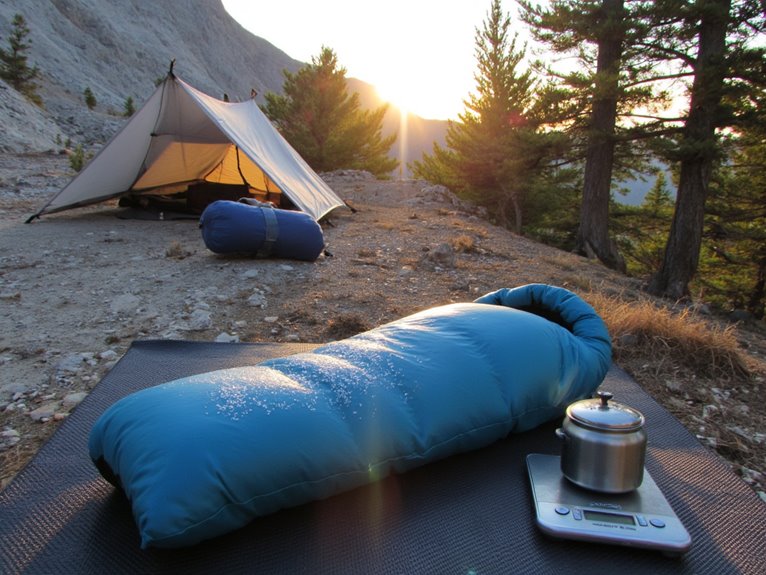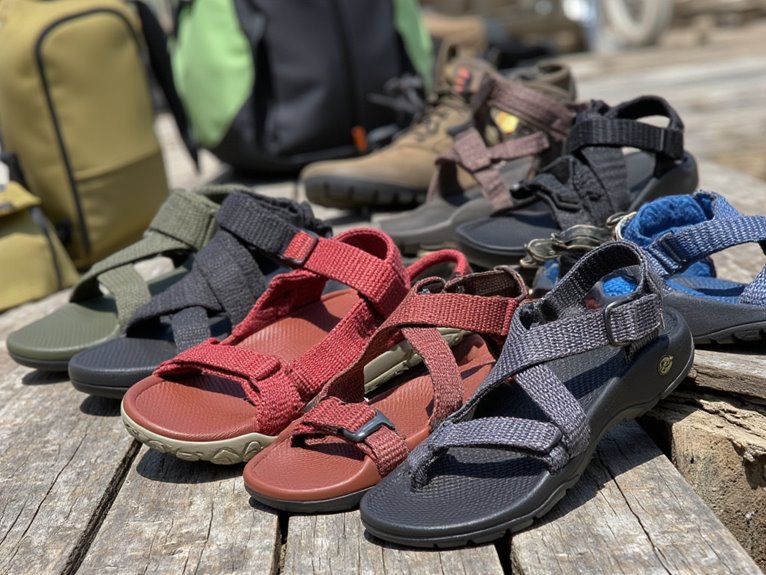How to Reduce Sleep System Weight Without Losing Warmth
You can reduce your sleep system weight by 15-20% without losing warmth through strategic material choices and integrated layering. Replace heavy down with advanced synthetic insulation like LoftTek’s hollow-filament polyester, which maintains performance when wet. Use WaveLoft construction’s W-shaped layers to maximize loft efficiency while cutting bulk. Select lightweight shell fabrics with thermal-resistance properties to save 200-400g. Add sleeping bag liners for 10-15°F extra warmth with minimal weight. The complete optimization approach reveals additional weight-saving opportunities.
We are supported by our audience. When you purchase through links on our site, we may earn an affiliate commission, at no extra cost for you. Learn more. Last update on 10th December 2025 / Images from Amazon Product Advertising API.
Notable Insights
- Choose synthetic insulation like LoftTek over down for wet conditions while maintaining similar warmth-to-weight ratios.
- Use advanced shell materials with integrated thermal-resistance properties to reduce total system weight by 200-400g.
- Implement strategic layering with base layers and liners to add 10-15°F warmth without significant weight increase.
- Select sleeping pads with high R-values and integrate all components as a unified thermal system for maximum efficiency.
- Apply WaveLoft technology and baffleless construction methods to optimize insulation distribution while eliminating unnecessary material weight.
Optimizing Insulation Materials for Maximum Efficiency
When choosing insulation for your sleep system, the material you select directly impacts both weight and thermal performance.
Synthetic innovation has produced materials like LoftTek that use hollow-filament polyester fibers for enhanced thermal efficiency.
Down provides superior warmth-to-weight ratios but loses effectiveness when wet. Synthetic insulation maintains warmth in damp conditions and dries faster than down.
For insulation comparison, down uses fill power ratings while synthetic materials rely on ISO/EN testing standards.
Siliconized fibers in synthetic insulation reduce static cling and improve water resistance.
Hybrid designs optimize performance by placing synthetic insulation where compression occurs and down where maximum loft is achieved.
Synthetic options cost less but typically weigh more per unit of warmth than equivalent down insulation.
High-quality down sleeping bags can achieve 800+ fill power ratings for maximum loft and warmth retention while maintaining superior compressibility for ultralight backpacking.
Strategic Fill Distribution and Layering Techniques
You can achieve 15-20% weight reduction through customized down placement in critical zones like torso and foot areas. Computer-aided design optimizes these fill distribution patterns, maximizing thermal output per ounce.
Effective layering strategies compound these gains. Your base layer traps initial body heat, reducing sleeping bag workload by 10-15 degrees. Mid-layers like fleece provide additional insulation without permanent weight penalties.
Strategic base layers reduce sleeping bag thermal demands by 10-15 degrees while fleece mid-layers boost warmth without adding permanent pack weight.
Sleeping bag liners add 5-10 degrees warmth for just 3-6 ounces.
High-quality insulating mats eliminate ground heat loss, allowing lighter bag ratings. Hooded designs retain 40% of body heat typically lost through your head.
Premium options like the Naturehike Ultralight utilize 650 fill power down insulation to achieve remarkable 20-ounce weights while maintaining comfort in temperatures down to 42°F.
This systematic approach delivers alpine-grade warmth while maintaining ultralight specifications.
Advanced Construction Methods That Reduce Bulk
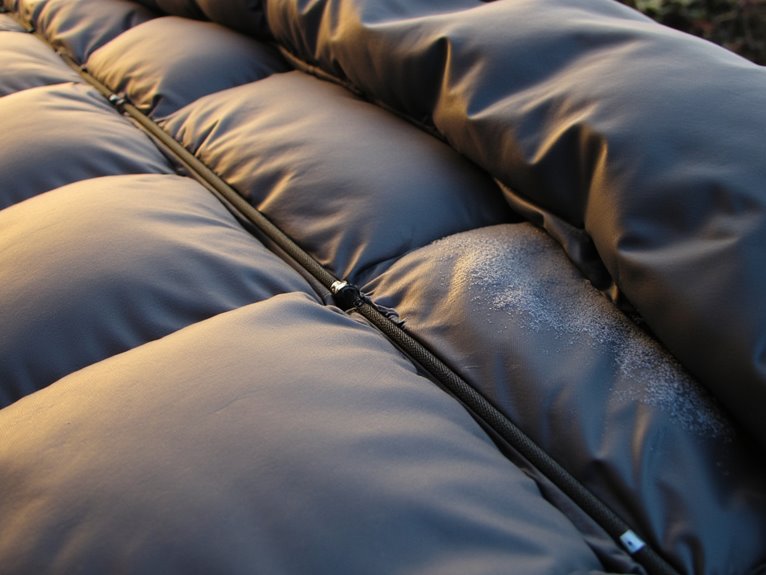
You’ll find that modern construction methods eliminate unnecessary bulk through three key innovations that dramatically reduce pack weight.
Baffleless synthetic designs remove traditional sewn-through construction, while WaveLoft technology creates continuous insulation layers without heavy baffle materials.
Diagonal shingle construction patterns distribute synthetic fill more efficiently than standard horizontal layering, cutting overall system weight by 15-25% compared to conventional sleeping bags.
These advanced synthetic constructions also maintain consistent warmth when exposed to moisture, unlike down insulation which can lose up to 90% of its thermal efficiency when wet.
Baffleless Synthetic Designs
Although traditional baffled sleeping bags have dominated the market for decades, baffleless synthetic designs represent a significant advancement in sleep system engineering that eliminates the need for internal fabric walls while maintaining superior insulation distribution.
You’ll find these baffleless designs benefits include reduced weight and simplified construction. The synthetic insulation advantages become apparent when you consider that materials like PrimaLoft maintain thermal properties even when wet, unlike down alternatives.
These designs use advanced techniques like shingling and diagonal layering to prevent insulation migration. You’ll achieve consistent warmth distribution without cold spots that plague traditional baffle construction.
The streamlined approach reduces manufacturing complexity, making these bags more cost-effective while delivering comparable thermal performance to heavier alternatives.
WaveLoft Technology Benefits
Innovation in insulation architecture reaches new heights with WaveLoft technology, which transforms how synthetic fill creates warmth while dramatically reducing bulk. WaveLoft advantages include W-shaped curved layers that maximize loft efficiency compared to traditional flat constructions. You’ll experience enhanced thermal efficiency through superior air trapping mechanisms.
| Feature | Traditional Flat | WaveLoft Technology |
|---|---|---|
| Loft Creation | Standard | Maximum |
| Air Trapping | Basic | Enhanced |
| Weight Efficiency | Moderate | Superior |
| Material Usage | Higher | Optimized |
| Thermal Performance | Good | Excellent |
The curved design traps more air pockets within each layer, creating better insulation performance per gram of fill material. You’ll get reliable warmth retention while carrying less weight. This technology maintains consistent performance across temperature ranges, making it practical for weight-conscious backpackers who need dependable synthetic insulation.
Diagonal Shingle Construction
Diagonal shingle construction represents another breakthrough in synthetic insulation architecture, building upon the efficiency gains seen with curved layer technologies.
You’ll find this method employs overlapping layers sewn in diagonal shingle patterns that eliminate cold spots while maximizing thermal efficiency. The insulation overlap creates continuous coverage without gaps, preventing heat loss through thermal bridging.
This construction technique reduces bulk by 15-20% compared to traditional quilted methods. Each shingled layer expands independently when you move, maintaining loft without adding weight. Synthetic polyester insulation works particularly well with this design, offering better shape retention than down alternatives.
The diagonal orientation distributes stress evenly across seams, enhancing durability.
You’ll appreciate the compact pack size—shingled bags compress 25% smaller than baffle-constructed equivalents while delivering equivalent warmth ratings.
Smart Fabric Selection for Lightweight Performance
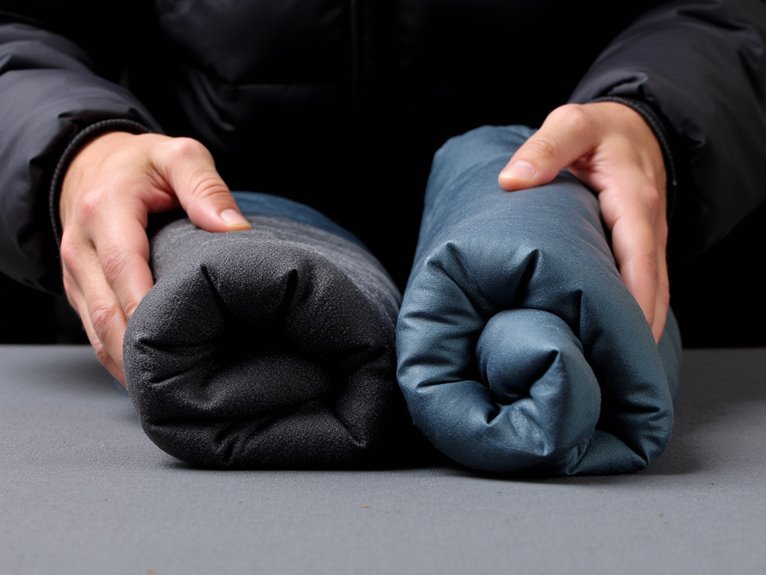
Your fabric choices determine whether you’ll carry extra ounces or shave critical weight from your sleep system.
Advanced shell materials now integrate thermal-resistant properties and moisture-wicking capabilities without the bulk penalties of traditional textiles.
The right fabric selection can reduce your total system weight by 200-400g while actually improving thermal performance through technologies like mica-infused yarns and nanotechnology-enhanced fibers.
Advanced Shell Material Technologies
Three revolutionary material technologies are transforming how outdoor gear manufacturers approach shell fabric design for weight-conscious sleep systems.
Monolithic membranes represent the most significant advancement in waterproof-breathable technology. Unlike traditional microporous films, these hydrophilic polyurethane membranes eliminate pore-clogging issues while delivering superior breathability across temperature ranges. You’ll achieve 100% waterproof protection without sacrificing moisture transfer efficiency.
Soft shell innovations combine exterior durability with midlayer insulation properties in single lightweight fabrics. These stretch-woven constructions incorporate tightly woven face materials with fleece backings, reducing your need for multiple heavy layers. Advanced soft shells eliminate traditional three-layer systems while maintaining wind resistance and thermal regulation.
Ultra-fine denier fibers maximize warmth-to-weight ratios in modern shell constructions. High-tenacity nylon fibers provide abrasion resistance without weight penalties, while ceramic micro-coatings deliver weather protection.
Moisture Management Fabric Properties
Smart fabric selection determines whether moisture accumulation becomes your sleep system’s heaviest liability or its greatest performance asset.
Moisture wicking efficiencies in synthetic fibers like polyester and nylon transport sweat from skin to fabric exterior, enabling rapid evaporation that prevents weight-adding moisture buildup. These materials maintain low moisture regain rates, absorbing minimal water while preserving structural integrity when wet.
Breathable fabric innovations featuring engineered cross-sections and specialized finishes optimize moisture transport without compromising insulation.
High air permeability accelerates evaporation rates, preventing dampness accumulation that increases system weight.
Advanced technologies like Coolmax® and Dri-QWick rapidly move moisture away from skin while maintaining warmth-to-weight ratios.
Unlike cotton, which retains moisture against skin, synthetic moisture-wicking fabrics keep you dry and your sleep system lightweight throughout varying temperature conditions.
Complete Sleep System Integration Strategies
While individual components like sleeping bags and pads receive most attention, achieving maximum warmth-to-weight efficiency requires treating your entire sleep system as an integrated unit.
Component synergy occurs when your sleeping pad’s R-value, bag’s temperature rating, and shelter’s weather protection work together seamlessly. This eliminates redundant insulation layers that add unnecessary weight.
Layer cohesion means coordinating your base layers, sleeping bag, and external weather protection. A 3-season bag rated to 30°F paired with an R-4 pad creates different thermal performance than the same bag with an R-2 pad.
Your tent’s ventilation design affects moisture management, which directly impacts insulation efficiency. Consider each element’s contribution to the complete thermal envelope.
Understanding that R-values are additive when stacking pads allows you to combine a lightweight summer pad with a minimal closed-cell foam pad to achieve winter-level insulation without carrying a single heavy winter pad.
This holistic approach can reduce total system weight by 15-20% while maintaining equivalent warmth ratings.
Essential Accessories That Boost Warmth-to-Weight Ratios
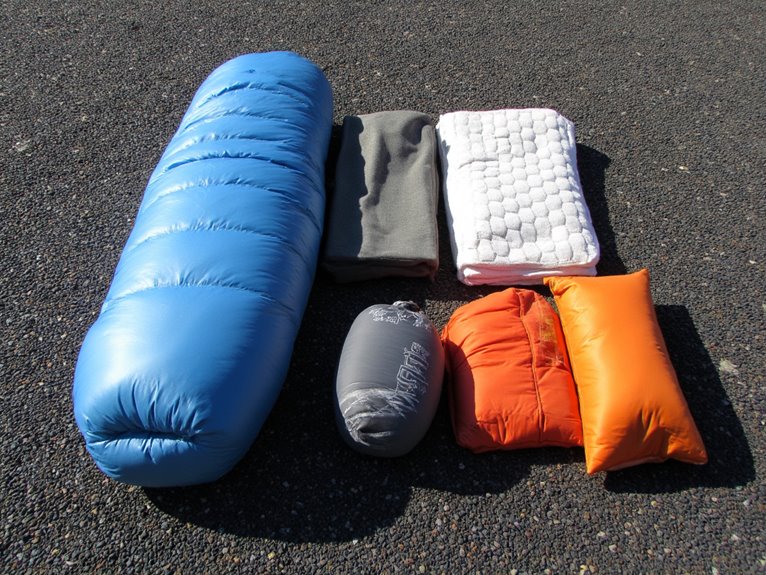
Beyond core sleep system components, strategic accessories can dramatically improve your warmth-to-weight ratio without requiring complete gear replacement.
Sleeping bag liners made from Thermolite or Coolmax add 10-15°F of warmth while weighing just 4-8 ounces. These liners also provide moisture management and extend your bag’s temperature rating considerably.
Insulated clothing worn during sleep maximizes body heat retention without adding bulk to your sleep system. Down vests, thermal socks, and insulated hats prevent heat loss from key areas. A 2-ounce merino wool beanie can prevent up to 40% of heat loss from your head.
Ultralight sleeping pads with high R-values provide ground insulation essential for warmth. The Tensor Extreme Conditions pad offers an R-value of 7.0 while weighing only 25 ounces, delivering exceptional insulation-to-weight performance.
Many lightweight sleeping bags feature synthetic insulation that maintains thermal performance in humid conditions while keeping pack weight under 3 pounds, making them ideal for ultralight backpacking setups.

